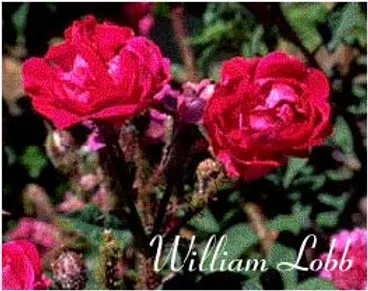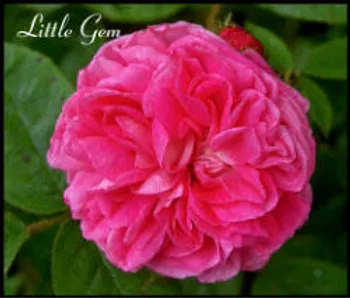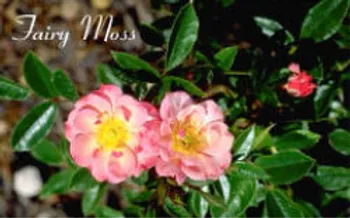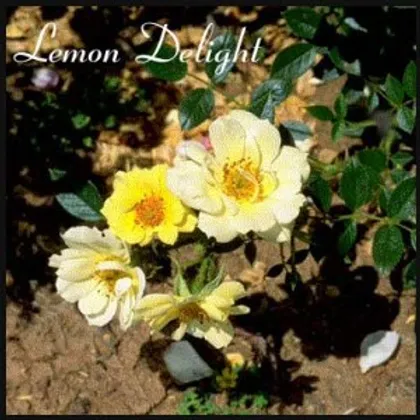
Over fifty years ago, in 1948, Ralph Moore began a program to breed and develop everblooming miniature moss roses. He had no idea about what he was actually letting himself in for. Fifteen years passed before he saw much in the way of real results and another 10 years after that before he would have any new miniature moss roses to sell to the public. Today, there are a number of miniature moss roses on the market, most are from Ralph Moore but some from other breeders as well. As they gain in popularity, we thought you might like to find out a little bit more about them.
Older Moss Roses
The original Moss Rose, a sport from Rosa centifolia, created quite a stir when it was first introduced in the early 1700′s. It was similar in appearance to R. centifolia except for numerous small glands on its flower buds and upper stems which create a mossy effect. The glands are scented and add to the fragrance of the flowers. If you touch the moss it feels sticky and leaves its scent on your fingers. This “moss” varies with each variety and may have its own distinctive fragrance.
Great things were predicted for Moss Roses. It is estimated that several hundred varieties were introduced, but today only a few are still grown. In size they range from dwarf varieties like Little Gem and Mousseline to tall pillar roses like Jeanne de Montfort and William Lobb, both of which are capable of reaching 8 feet.
When Little Gem was introduced in 1880, its raiser, William Paul, actually described it as a miniature Moss Rose. This, in spite of the fact that it can grow to 3 to 4 feet and has blossoms that are about 3 inches across. The bush is densely covered with small, double crimson flowers with an old-fashioned look. It was very popular with the Victorians.

Mousseline (also known as ‘Alfred de Dalmas’) is a continuous-blooming Moss Rose that was also very popular. The fragrant creamy-pink blossoms are semi-double with a center of deep golden stamens.
Graham Stuart Thomas tells us that Jeanne de Montfort, one of the most vigorous Moss Roses, apart from William Lobb, boasts burgundy-colored moss and frilly clear pink flowers.
William Lobb (‘Duchesse d’Istrie’, ‘Old Velvet Moss’) was introduced in 1855 and is still one of the most popular Moss Roses both because of its large size and the color of its flowers. Peter Beales describes the flowers as “a mixture of purple, grey, magenta, and pink…”
During the better part of the 18th century and up until the close of the 19th century moss roses were very popular because they were unusual, hardy, and fragrant. However, they are difficult to breed — they set few or no hips and produce little, if any, pollen.
In spite of this, several modern varieties have been bred. Nearly all are tall growing, spring flowering and not too different from the old Moss Roses. From Mr. Moore’s point of view, of these Golden Moss and Gabriel Noyelle were the most significant.
Golden Moss (Moss, Dot, 1932) resulted from a cross of Frau Karl Druschki x (Souv. de Claudius Pernet x Blanche Moreau). Ralph Moore has used this rose extensively in his breeding program. In growth habit, it is similar to its seed parent, Frau Karl Druschki, a large, white Hybrid Perpetual. Its other parent is the product of a cross between Souv. de Claudius Pernet, a yellow Hybrid Tea, and Blanche Moreau, a white Moss. Golden Moss has well-mossed buds and its flowers are a soft peach-yellow. It is once-blooming.
The parents of Gabrielle Noyelle (Moss, Buatois, 1933) are Salet, a pink Moss, and Souv. de Mme. Krueger, a salmon-orange Hybrid Tea. Gabrielle Noyelle has well mossed buds, soft salmon-pink flowers, and it is repeat-blooming.
Ralph Moore’s Early Successes
Ralph Moore’s first successful Moss rose was O.M. (“Orange Moss”). To obtain it, he crossed Mark Sullivan (Hybrid Tea, Mallerin, 1942, and which Stirling Macoboy in The Ultimate Rose Book, describes as “a lovely blend of gold all veined and shaded with scarlet”) with Golden Moss. All of the resulting seedlings were tall-growing (8 ft. to 10 ft.) once-bloomers and only one of them was really mossed. That was O.M. It has flowers that change from a bright orange to orange-pink as they mature. Although it sets few hips, it produces pollen abundantly.
In order to recover the repeat blooming characteristic, Mr. Moore had to make many more crosses with O.M. as the pollen parent and hybrid tea and floribunda varieties as the seed parent. But in doing so much of the Moss was lost.
Goldmoss (Floribunda/Moss, Moore, 1972) is Ralph Moore’s first clear yellow bush type everblooming moss rose. [Ed. Note: Modern Roses 10 lists it as a Floribunda.] Mr. Moore crossed a yellow Hybrid Tea seedling with O.M. which resulted in a number of yellow and orange-colored moss roses. Nearly all were tall growing once-bloomers. He took one of the best of these, a clear yellow, and crossed it with the floribunda Rumba (Poulsen, 1958). Goldmoss was the result.
Rougemoss (Floribunda/Moss, Moore, 1972) resulted from a cross of Rumba with an unnamed seedling itself descended from Pinocchio (Floribunda, Kordes, 1940), William Lobb, Red Ripples (Floribunda, Krause, 1942), and O.M. This cross produced a number of bush moss roses in colors ranging from medium pink to red and orange red.

In his 1978 monograph entitled The Breeding and Development of Modern Moss Roses, Ralph Moore said that he believed that Rougemoss and Goldmoss had within their gene pools the makings of the new moss roses of the future. Since that time, Goldmoss has figured in the parentage of a number of roses, like Apricot Twist, Playgold, and Yellow Mini-Wonder, to name a few. But most of these offspring have not displayed any mossing. One exception is Paintbrush (Miniature, Moore, 1975), the product of a cross with Fairy Moss. This rose has mossy apricot-yellow buds which open into 10-petaled daisywhite flow.
Miniature Moss Roses Today
Fairy Moss is the first of Ralph Moore’s repeat-blooming miniature moss roses. It was introduced in 1969. It had taken over two decades of work to reach this point! The buds, which are lightly mossed, and flowers of this rose are a bright medium pink and it sets seed readily. Fairy Moss has proven to be a fertile parent. In fact, it has figured in the parentage of just about every miniature moss rose on the market today.
To give you an idea of the range of the miniature moss roses, here is a sampling. All of these roses are repeat-blooming and to lesser or greater degrees show mossing.
Kara (Moore1972, aka ‘Dear One’) is the result of a cross of Fairy Moss x Fairy Moss. Mossy buds open into single (5 petals), 1-1/4″ rose-pink flowers. It makes a low, very compact plant that covers itself with tiny very mossy buds borne singly and in clusters.
Dresden Doll (Moore 1975) is one of the better known miniature moss roses — it’s offered by nurseries in Canada and Europe, as well as the United States. It has heavily mossed buds which open into double soft pink fragrant flowers that Stirling Macoboy in The Ultimate Rose Book describes as “perfect replicas of an old-fashioned, full-sized Moss Rose.”

Lemon Delight (Moore, 1978), like Paintbrush, is the result of a cross of Fairy Moss and Goldmoss. As you may have surmised from the name, the flowers are lemon-yellow in color, but the moss on the buds smells like lemon, too!
Strawberry Swirl (Moore 1978) has 48 red-and-white-striped petals. The blossom is similar in its striping to ‘Rosa Mundi’, but formed like a Hybrid Tea.
Double Treat (Moore 1986) has mossy buds that open into rosy-red and orange-yellow striped, almost hand-painted, blossoms — each one unique.
Scarlet Mosstm (Moore 1988) has been described as outstanding and the reddest of any moss rose. It descends from the red climber, Dortmund (Kordesii, Kordes, 1955), crossed with a miniature moss seedling and a striped miniature moss seeding.
Secret Recipe (Moore 1994), the offspring of the yellow floribunda, Little Darling, and an unnamed seedling, has 2-inch red-and-white striped blossoms.
The Miniature Moss Rose Story continues in Part II with an in-depth look at Crested Sweetheart, a climber that Mr. Moore introduced in 1988. The flower is old-fashioned in appearance with wonderful mossing ala Chapeau de Napoleon on its buds.




























































